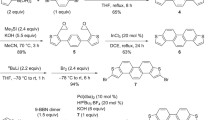Abstract
A comparison of the electrical characteristics of organic field-effect transistors (OFETs) based on derivatives of the electron-conductor perylene tetracarboxylic diimide (PTCDI) in top-contact configuration is presented. The derivatives used are N,N′-dimethyl-3,4,9,10-perylene-tetracarboxylic-diimide (DiMe-PTCDI), N,N′-diphenyl-3,4,9,10-perylene-tetracarboxylic-diimide (DiPhenyl-PTCDI), N,N′-dimethoxyethyl-3,4,9,10-perylene-tetracarboxylic-diimide (DiMethoxyethyl-PTCDI), N,N′-di(3-pentyl)-3,4,9,10-perylene-tetracarboxylic-diimide (Di3Pentyl-PTCDI), and N,N′-diheptyl-3,4,9,10-perylene-tetracarboxylic-diimide (DiHeptyl-PTCDI). Current/voltage measurements were first performed in situ and later ex situ. Additionally, the effect of annealing and bias stress was probed in situ. A strong influence of the different side groups on the order of magnitude of the electron mobility is revealed, ranging from 4×10−6 cm2/V s for DiMethoxyethyl-PTCDI to 5×10−2 cm2/V s for DiHeptyl-PTCDI. While none of the devices was stable in air after exposition to air, only the DiMe-PTCDI one resumed its functionality after restoring vacuum conditions. The dielectric functions of the derivatives was derived, additionally revealing optical isotropy for all films and varying surface roughness. While DiHeptyl-PTCDI and Di3Pentyl-PTCDI, yielding also the highest electron mobilities, form smooth layers with negligible surface roughness, strong island formation was be observed for DiPhenyl-PTCDI and DiMethoxyethyl-PTCDI, yielding low mobilities. This island growth was also confirmed by atomic force microscopy measurements. Ageing of the samples for several months under ambient conditions leads to increased roughness for the very rough samples. Layers with smooth surface, on the other hand, showed no significant change in the dielectric behavior of the sample.
Similar content being viewed by others
References
P.R. Malenfant, C.D. Dimitrakopoulos, J.D. Gelorme, L.L. Kosbar, T.O. Graham, Appl. Phys. Lett. 80, 2517 (2002)
H. Graaf, D. Schlettwein, J. Appl. Phys. 100, 126104 (2006)
G. Horowitz, F. Kouki, P. Spearman, D. Fichou, C. Nogues, X. Pan, F. Garnier, Adv. Mater. 8, 242 (1996)
J. Sindu Louis, D. Lehmann, M. Friedrich, D.R.T. Zahn, J. Appl. Phys. 101, 013503 (2007)
O.D. Gordan, T. Sakurai, M. Friedrich, K. Akimoto, D.R.T. Zahn, Org. Electron. 7, 521 (2006)
M. Scharnberg, R. Adelung, F. Faupel, Phys. Stat. Sol. (a) 205, 578 (2008)
R. Scholz, D. Lehmann, A.-D. Mueller, F. Mueller, D.R.T. Zahn, Phys. Stat. Sol. (a) 205, 591 (2008)
G. Horowitz, P. Lang, M. Mottaghi, M. Cavallini, H. Aubin, Adv. Funct. Mater. 14, 1069 (2004)
N. Benson, C. Melzer, R. Schmechel, H. von Seggern, Phys. Stat. Sol. (a) 205, 475 (2008)
M. Friedrich, C. Himcinschi, G. Salvan, M. Anghel, A. Paraian, T. Wagner, T.U. Kampen, D.R.T. Zahn, Thin Solid Films 455–456, 586 (2004)
G. Salvan, S. Silaghi, B. Paez, G. Baumann, T.U. Kampen, R. Scholz, D.R.T. Zahn, J. Cryst. Growth 275, e1155 (2005)
Author information
Authors and Affiliations
Corresponding author
Rights and permissions
About this article
Cite this article
Lehmann, D., Zahn, D.R.T. The electrical and dielectrical behavior of n-conducting perylene tetracarboxylic diimide derivatives. Appl. Phys. A 95, 203–207 (2009). https://doi.org/10.1007/s00339-008-5020-2
Received:
Accepted:
Published:
Issue Date:
DOI: https://doi.org/10.1007/s00339-008-5020-2




